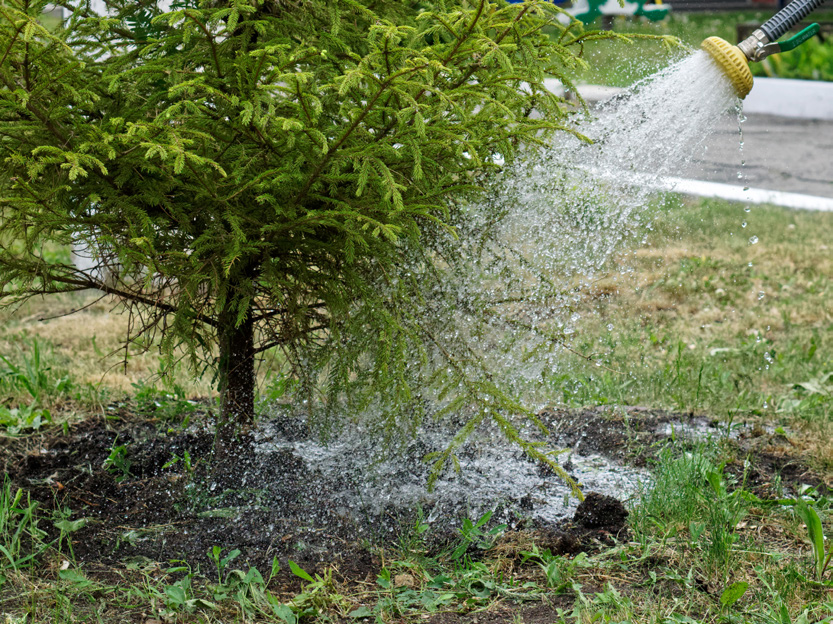Master Gardener Spotlight: Watering Evergreens for Winter
In the fall, it is easy to forget that some trees are not slowing down as much as others for the season. These trees often require supplemental water in autumn. Evergreens, trees and shrubs that keep their needles or leaves year-round, lose moisture throughout the year through transpiration. Transpiration is when a plant pulls water from the soil and moves it through the tree. Water that the tree does not need is released from stomata, or an opening on the needles and leaves. This process allows trees to bring water from the roots to the upper canopy. Evergreen trees can dry out in winter months if they can’t access as much water as they are losing through transpiration. This is especially an issue in drier winters and can be more severe for broadleaf evergreens (which have a larger leaf area for transpiration). Deciduous trees that lose their leaves in the fall transpire minimally during the winter months through their bark.
Timing is a critical component when it comes to autumn tree watering. In September, reduce watering to allow any new growth to become more hardy before winter. If a tree has fleshy, new growth late in the season, it may freeze once temperatures dip. Trees should be watered at midday when temperatures are above 40 degrees and there is no snow cover. Once snow cover is established, there is no need to water. Snow cover insulates plant roots from wind and sub-zero temperatures.

Evergreen trees can dry out in winter months if they can’t access as much water as they are losing through transpiration. Photo: Eva Grimme, MSU Extension
Water the area directly underneath the tree’s canopy and beyond the dripline if possible. The dripline can be determined by looking at the area on the ground below the perimeter of the tree’s longest branches (imagining where water would drip if the tree was an umbrella). This area is called the critical root zone. It is important to consider that tree roots can exist in an area twice the size of the canopy. Watering trees at the trunk base is not as beneficial to the tree as watering the area further away from the trunk.
Once the leaves of deciduous trees fall, water evergreens slowly and deeply to a depth of 12 inches. Nearly all tree roots exist in the top 12–26 inches of soil. Watering slowly promotes deep penetration of water to the whole root system. If water is applied quickly, it penetrates only the first few inches of the soil and fails to substantially water the tree. Newly planted trees are more prone to winter injury due to their underdeveloped root systems. Ten gallons of water for every inch of tree trunk diameter, every week, will be beneficial to newly planted trees. Mature trees with well-developed root systems have more access to water but still benefit from water in the fall or winter if they do not exist in an irrigated landscape. Another tactic to reduce water loss is to apply mulch to the area underneath the tree canopy. A four-inch layer of organic mulch (such as arborist wood chips) applied to the root zone can insulate the soil and reduce water loss.
Trees that are stressed during the winter are more susceptible to insects and disease. Fall watering can reduce the chance of trees being weakened during the winter and set them up to be healthier and more successful in the following growing season. Unpredictable Montana winters can pivot from one extreme to another, the one variable that does not change is that evergreens need water going into winter.

Watering trees at the trunk base is not as beneficial to the tree as watering the area further away from the trunk. Photo: Adobe Stock
Sarah Eilers is the MSU Extension Master Gardener Coordinator.
